What is SIEM?
Security information and event management (SIEM) is an advanced cybersecurity solution designed to centrally aggregate and correlate security data from various sources within your network. SIEM plays a crucial role in protecting against sophisticated cyberattacks and ensuring compliance.
Gartner® introduced the term SIEM in 2005 to address the necessity for centralized security monitoring. Today, SIEM solutions cater to a wide range of enterprise security requirements, including advanced threat detection and compliance. They also provide operational management capabilities such as incident management, reporting, and security analytics dashboards.
Why SIEM?
Security professionals often face challenges in aggregating security data from various applications and devices across the network. They frequently lack comprehensive visibility, which is crucial for promptly detecting and addressing cyberthreats, assessing the impact of cyberattacks, and proactively enhancing their network’s security posture.
Unlike other security solutions that focus on specific functionalities, SIEM is a configurable security platform that provides a comprehensive overview of both on-premises and cloud environments. SIEM tools significantly improve security visibility, enable real-time threat detection, and facilitate compliance management, thereby strengthening network security. By integrating artificial intelligence (AI), these tools automate remediation processes, predict adversaries’ next steps, and reduce the workload of security analysts. They provide actionable insights and empower security teams to counter adversarial techniques effectively
"With ManageEngine Log360, we were able to detect and remediate a worm attack 20 times faster."
How SIEM works
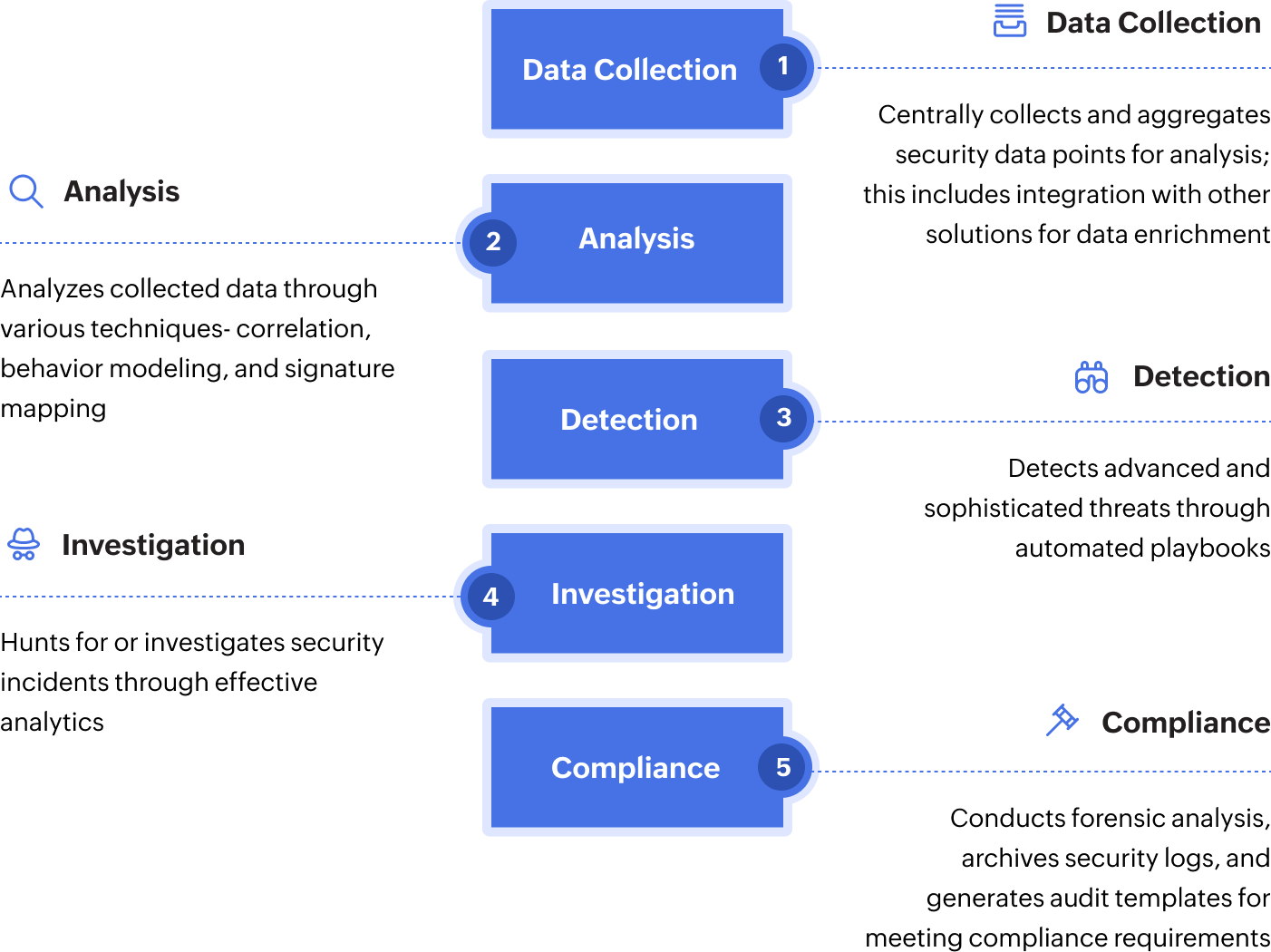
Figure 1: How SIEM solutions work.
The most fundamental function of any SIEM tool is to aggregate security data points, primarily logs and events, in a centralized location. If you opt for an on-premises SIEM solution, your data will be hosted on a server and at a later point archived within a secondary storage device for easy retrieval. If you opt for a cloud-based SIEM solution, your data will be stored in the cloud in the vendor’s environment. Centralized log data aggregation is a key strength of any SIEM solution because it provides security analysts with comprehensive visibility across the network and facilitates forensic analysis at a later stage.
The second primary function of a SIEM solution is to analyze the collected data and deliver actionable insights. This analysis employs various techniques, including correlation, behavior analytics, and trend visualization. Real-time correlation enables analysts to link multiple seemingly unrelated events to identify patterns for effective threat detection, which is a core function of any SIEM tool. Behavior analytics, often powered by machine learning or AI, helps establish baselines for user and entity behaviors and activities to detect anomalies, thereby enhancing threat detection accuracy. SIEM tools typically combine static detection rules with anomaly models to detect threats with high precision and accuracy.
Want to learn about ManageEngine's threat coverage?
Check out our exhaustive threat detection rule library.
Additionally, SIEM solutions support continuous security monitoring for change management and user activity monitoring use cases, which are essential for most compliance requirements. With log data archiving, forensic analysis, and security monitoring features, adopting a SIEM solution becomes a crucial component of any compliance journey.
SIEM capabilities
Log management
The ability to analyze log events and other data across disparate sources is a core functionality of a SIEM solution. The centralized collection and storage of security data points allows for real-time monitoring, historical analysis, and quick identification of security incidents. By centralizing and correlating security logs, SIEM software enhances visibility into network activities, supports compliance requirements, and facilitates efficient incident response and forensic investigation.
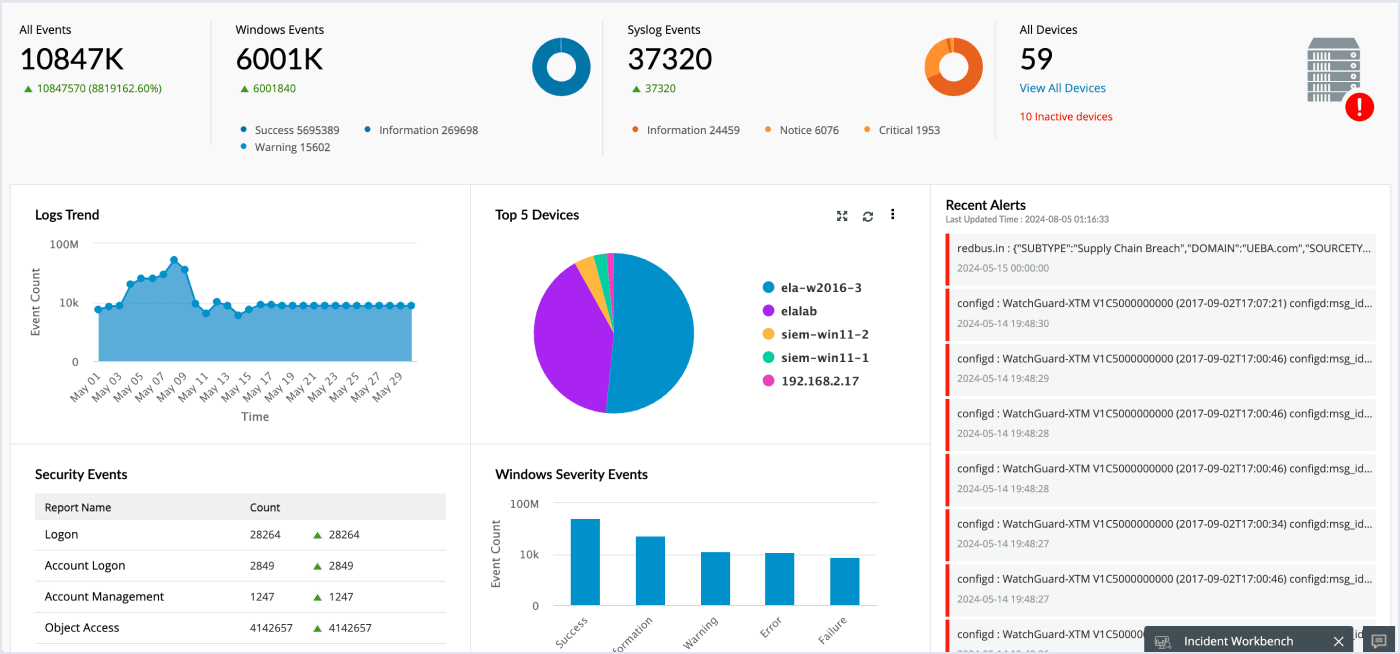
Figure 2: Log360's Events Overview dashboard.
Threat detection
By leveraging advanced analytics, correlation rules, and machine learning, SIEM solutions can detect anomalies, suspicious activities, known attack patterns, and security threats. Often, SIEM vendors also align with threat modelling frameworks such as MITRE ATT&CK to efficiently detect the tactics, techniques, and procedures involved in cyberattacks.

Figure 3: Log360's Threat Analytics dashboard.
Interested in knowing how SIEM solutions handle false positives?
False positives, or alerts on non-real threats, are huge problems for today's security operations centers. SIEM systems are evolving every day to handle false positives in threat detection. Today's new-gen SIEM tools use several methods, including:
Tuning and customization
Fine-tuning SIEM systems to the specific environment and threat landscape of an organization is the first step in reducing false positives. This involves adjusting correlation rules and thresholds to adapt to your environment. SIEM tools act as a customized platform to facilitate the fine-tuning and optimization needed for an enterprise.
Machine learning and AI
Advanced SIEM solutions utilize machine learning algorithms to learn from past incidents and improve accuracy over time. This helps in differentiating legitimate activity from actual threats. Log360 utilizes smart thresholds powered by machine learning algorithms to understand your network's behavior and detect threats accurately without having to specify thresholds.
Contextual analysis
SIEM software incorporates contextual information such as user details, user risk scores, vulnerability information, and asset criticality to better assess the severity of an alert and reduce false positives. Check out Log360's contextual and guided investigation feature that enriches your alert information.
Feedback loops
Security analysts can provide feedback on alerts, which the SIEM system uses to refine its detection capabilities. This continuous improvement process helps in minimizing false positives.
Security orchestration
SIEM solutions often integrate and orchestrate with other security tools, such as endpoint detection and response (EDR) solutions and intrusion detection systems, to corroborate alerts and reduce false positives.
Security analytics for threat investigation
SIEM solutions provide a guided and contextual analysis platform for security operations analysts to investigate a reported incident effectively. They bring together network traffic, user behavior, and external threat intelligence to enhance threat investigation. SIEM tools' security analytics capability uncovers hidden threats and attack vectors to expedite incident response. This capability is crucial for pinpointing the root cause of security incidents, preventing future attacks, and demonstrating compliance with industry regulations.
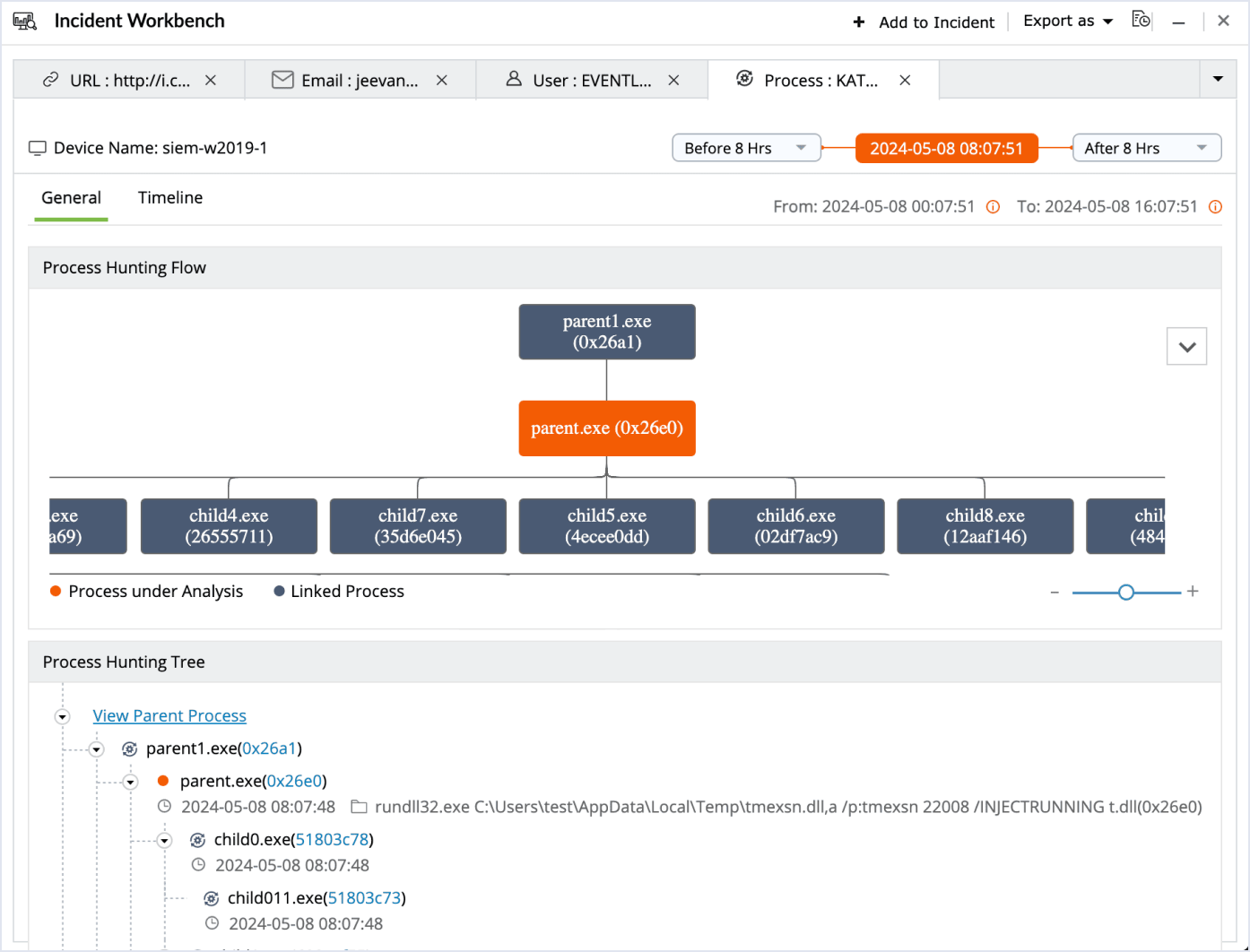
Figure 4: Log360's process hunting lineage analytics.
Automated threat response
By leveraging real-time data analysis and predefined playbooks, SIEM systems swiftly identify and mitigate threats, reducing response times and minimizing potential damage. Scripting predefined actions based on specific threat indicators or triggers, SIEM solutions automatically mitigate threats, reducing human intervention and response times. From blocking malicious IP addresses and isolating compromised systems to blocking a user from access, threat response automation ensures security teams focus on strategic initiatives while ensuring rapid and effective incident handling. SIEM solutions use their integrations and orchestration to achieve efficient workflow execution across different tools and platforms used.
Compliance management
By centralizing security data and automating reporting, SIEM solutions streamline and simplify the process of demonstrating adherence to industry regulations such as the GDPR, the PCI DSS, and HIPAA. With robust audit trails, real-time monitoring, predefined audit reports, and violation alerts, organizations can proactively identify compliance gaps and mitigate risks effectively. Further, new-gen SIEM solutions continuously assess the network environment against industry standards and mandates to spot risks and compliance gaps and offer a comprehensive risk posture overview.
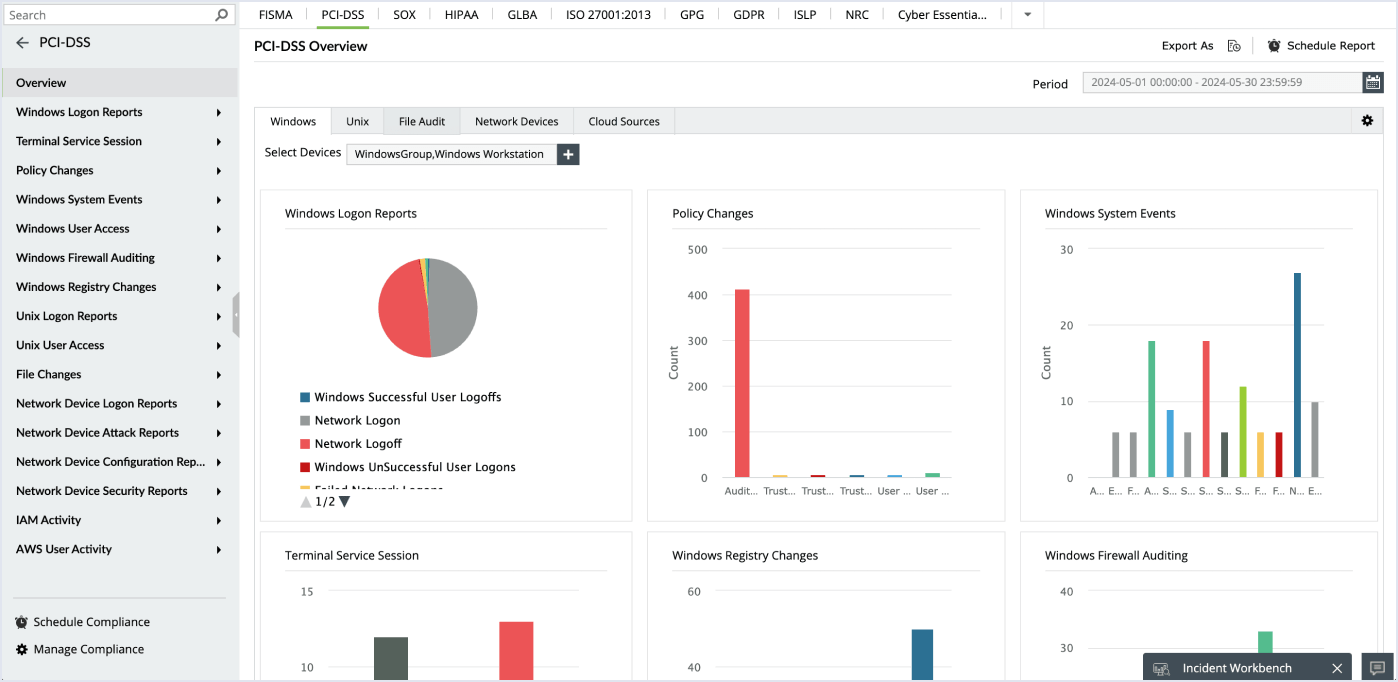
Figure 5: Log360's Events Overview dashboard.
Check out Gartner's 2024 Magic Quadrant™ for SIEM to know more about the critical capabilities of SIEM solutions and vendor positioning.
What next ?
Are you learning and educating yourself about cybersecurity and SIEM?
Here are some related sources
- Ebooks
- Whitepapers
- Case Studies
Essential SIEM use cases for modern security operations
Enterprise security operations tailor their security use cases based on factors such as organizational size, business nature, security maturity, and industry sector. Gartner advises maintaining a well-structured and continuously improving set of security use cases to ensure they remain valuable and relevant to security operations, rather than becoming obsolete documents. Formulating strong security use cases drives the implementation of SIEM solutions.
SIEM solutions, serving as the central hub for security data, are among the most effective tools for implementing a wide range of security use cases. Their orchestration and integration capabilities make them particularly valuable for threat detection, compliance management, and continuous monitoring.
According to Gartner, security use cases can be broadly classified per the below figure.
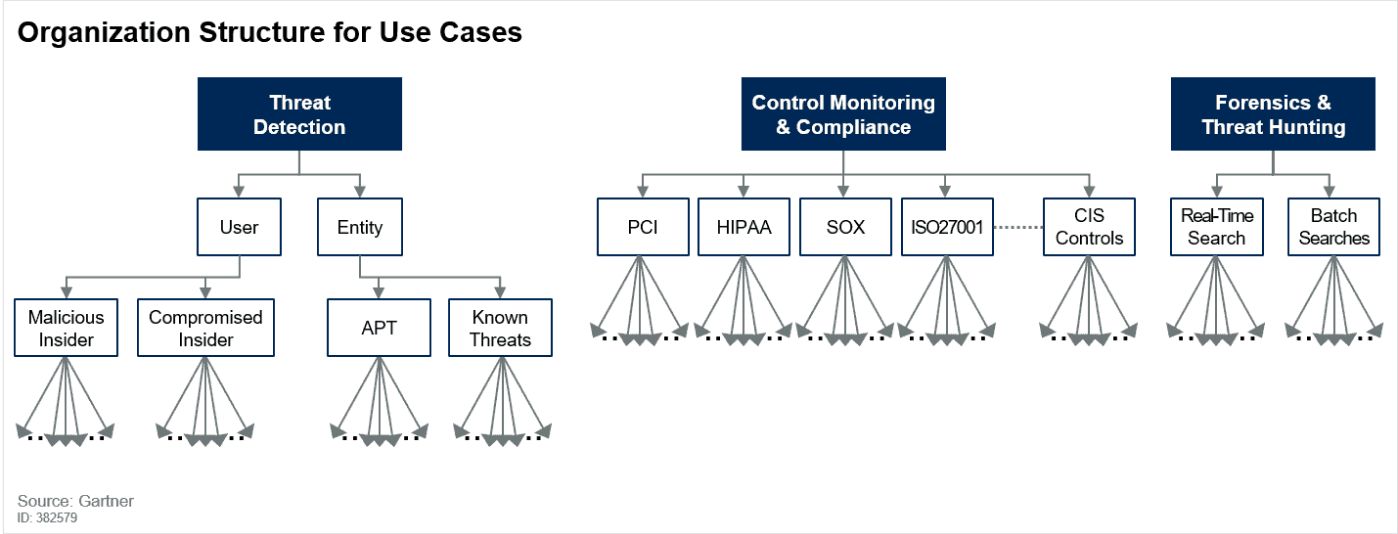
SIEM solutions help you meet all three categories of these use cases—threat detection, compliance and continuous monitoring, and forensic investigation and threat hunting.
Top SIEM use cases to implement
SIEM for threat detection
Malicious insider threat detection
Detect suspicious insider activities, such as unusual access to a critical resource, data exfiltration attempts, or abnormal logons, using the behavioral analytics capability of SIEM systems. Integrate a user risk management system with behavioral analytics to detect slow and persistent insider attacks, account compromises, and more.
Compromised user detection
Spot credential leaks or unusual usage of a user account to detect user account compromises. Fine-tune your SIEM detection rules to monitor indicators of attack, such as logons from unusual locations or at unusual times or multiple logons within a short span of time from different geolocations. This can help you detect compromised user accounts.
ManageEngine's SIEM solution, Log360, includes dark web monitoring to detect credential leaks and other user information on the dark web. Get alerted about leaks on the dark web and automate proactive measures, such as credential resets or account lock-outs, before adversaries can use them to take over your user accounts.
Advanced persistent threat detection
Detect advanced and complex threats, like lateral movement, privilege escalation, data exfiltration, or credential access, using correlation rules and machine-learning-driven anomaly detection. Mapping rules to the MITRE ATT&CK threat modelling framework's tactics and techniques helps assess the threat coverage you get out of SIEM implementation.
Known threat detection
Look for SIEM solutions that have built-in integration with threat intelligence platforms to enhance their known threat detection capabilities. SIEM tools often come with a rich threat repository of their own to detect malicious IP addresses, URLs, domains, and indicators of compromise. They also offer playbooks to detect and instantly mitigate known threats.
Check out Log360's playbook to detect and mitigate intrusion attempts from known malicious sources.
SIEM for controls and compliance monitoring
The essence of controls and compliance monitoring is data aggregation and the ability to generate audit reports out of it. SIEM systems play a crucial role in this by providing real-time visibility into security events; generating compliance reports for mandates like the PCI DSS, HIPAA, the GDPR, SOX, and FISMA; and ensuring data protection by design.
Further, to facilitate effective user activity monitoring, SIEM solutions track changes to user credentials and access patterns to detect unauthorized changes and ensure compliance with internal policies. SIEM solutions collect and audit system and security logs, making it easier to generate detailed compliance reports and conduct forensic analysis in the event of a security breach.
SIEM for forensics and threat hunting
SIEM systems enhance forensic analysis and threat hunting in security operations through their search and correlation functions. They enable batch searches on historical log data, assisting security teams in investigating past incidents and identifying patterns or trends. By leveraging historical correlation and search capabilities, SIEM software reveals long-term trends and patterns crucial for effective forensic analysis. Additionally, the security analytics features of SIEM software, including automated incident timelines, process lineage visualizations, attack path visualizations, and contextual user mapping, facilitate comprehensive analysis of security events and efficient threat hunting.
Role of SIEM in cybersecurity
SIEM functions as a comprehensive security platform rather than a single solution offering specific capabilities. Since its inception by Gartner in 2005, SIEM has evolved significantly, continually adapting to the dynamic changes and needs of the market.
Initially a simple approach to log and compliance management, SIEM has transformed into a next-generation technology. The key distinctions between SIEM and other technologies, particularly threat detection and response solutions like EDR, network detection and response (NDR), and extended detection and response (XDR), are as follows:
-
Holistic approach
SIEM encompasses data collection and analysis, operating independently from other vendors that often rely on additional technologies for effective functioning.
-
High customizability
No single solution can meet the diverse security needs of different industries. To ensure optimal security, it is essential to customize and fine-tune the security solution to the specific requirements of the enterprise. SIEM platforms are highly customizable.
-
Integration
SIEM solutions act as a security hub, aggregating data from all parts of the network. They are highly scalable and flexible, particularly with the shift to cloud-based solutions. Cloud SIEM solutions, with extensive integration and high-speed analytical capabilities, can provide enterprises with timely insights.
Explore Log360's integrations
How SIEM differs from other security tools
Often, SIEM solutions are compared with other evolving security tools, such as security orchestration, automation, and response (SOAR) and XDR. Enterprises frequently face confusion regarding which tool to select and for which specific needs. The table below illustrates the fundamental differences between log management, SOAR, XDR, and SIEM solutions. To choose an appropriate security solution, we recommend reviewing your security requirements, considering the use cases for which you need a security tool, assessing deployment methods, and determining the resources you plan to invest.
| Feature | Log management | SOAR | XDR | SIEM |
|---|---|---|---|---|
| Primary function | Collect, store, and search logs | Orchestrate security workflows and automate responses | Unified detection and response across multiple security layers | Collect, correlate, and analyze security events |
| Scope | Enterprise-wide | Enterprise-wide | Extended to endpoints, networks, servers, and cloud workloads | Enterprise-wide |
| Data focus | All logs (security and non-security) | Security incidents and workflows | Security telemetry from multiple sources | Security events |
| Typical use cases | Log retention, log searching, and compliance reporting | Incident response automation, playbooks, threat hunting, and orchestration | Advanced threat detection, incident response, and threat hunting | Threat detection, incident response, compliance, and security monitoring |
| User interface | Centralized dashboard | Centralized dashboard | Centralized dashboard | Unified view across multiple tools |
SIEM vs. SOAR: What's the difference?

SIEM benefits for enterprises and small businesses
SIEM for security teams
SIEM empowers security teams with real-time visibility into network activities, enabling rapid threat detection and response. By correlating vast amounts of data, SIEM solutions help identify anomalies, suspicious activities, and potential attacks. This enhanced situational awareness allows security teams to prioritize incidents, reduce response times, and improve overall security posture.
SIEM for IT operations
SIEM offers IT operations teams valuable insights into system performance and health. By monitoring logs from various IT components, teams can identify potential issues, optimize resource utilization, and ensure service availability. SIEM solutions also aid in capacity planning, troubleshooting, and compliance reporting, streamlining IT operations.
SIEM for business leaders
SIEM provides business leaders with a comprehensive overview of the organization's security posture and risk landscape. By quantifying security risks and demonstrating compliance with industry regulations, SIEM helps protect the company's reputation and bottom line. Additionally, SIEM can help optimize IT investments by identifying areas for improvement and demonstrating the value of security initiatives.
Looking to implement a SIEM solution?
Are you considering implementing a SIEM solution? Here are some quick steps you need to consider.
Pre-deployment checklist:
1. Formulate security use cases
Document and maintain the security use cases for which you are considering deploying a SIEM solution. This will help you choose the right deployment method for the SIEM solution and fine-tune its capabilities to meet your needs.
2. Ascertain resources
Assess and come to a conclusion about the resources you are ready to invest in deploying and maintaining a SIEM solution. This includes hardware spending as well as paying the analysts who will be using the SIEM deployment. If you have a small security operations team and a limited budget for hardware spending, go for a cloud-based SIEM solutions since they are easy to maintain with no upfront hardware spending.
3. Choose the deployment method
SIEM solutions come with various deployment options, including on-premises deployment, cloud SIEM solutions, and managed SIEM solutions. Depending on the resources and your organization's security maturity, choose the deployment method that best suits you.
Deployment checklist:
4. Ingesting the right data
Be it compliance monitoring or threat detection, your SIEM solution works best if you configure the right data sources and ingest the right data into it. Most false positives in SIEM are attributed to poor data ingestion practices. Sit with your SIEM vendor or managed service provider to provide visibility into your environment and configure the data right.
5. Configuring detection rules
Depending on the use cases you've chosen, test and configure correlation and anomaly rules. Remember to optimize the rules regularly as your environment keeps changing.
6. User access setup
Set up user accounts and role-based access to your SIEM solution based on your defined access control policies.
7. User training
Provide ongoing training to users of the SIEM solution for optimal utilization and to ensure they are proficient in using it.
Post-deployment maintenance
8. Continuous monitoring
Continuously monitor the performance of the SIEM solution and match it with your goals. Ensure that your SIEM solution is collecting and processing data as expected.
9. Alert management
Review and respond to alerts generated by your SIEM software. Set up a procedure to handle alerts based on criticality or business division to address issues immediately.
10. Performance tuning
Regularly check the efficacy of detection rules and keep optimizing them to reduce false positives and improve the accuracy and precision of detection.
AI in SIEM: Overcoming challenges
Vendors are integrating AI into their SIEM systems to enhance threat detection, predictive analytics, and automated responses. AI-driven SIEM solutions address the current challenges of SIEM deployment, including false positive generation, increased response time, and lack of proactive security implementation. With AI capabilities, SIEM solutions can:
- Improve accuracy by reducing false positives through smart thresholds.
- Enhance security analytics with predictions, enabling proactive security approaches.
- Accelerate incident response by bringing in security telemetry and impact analysis based on criticality, and by suggesting remedies for neutralizing threats.
Improve accuracy by reducing false positives through smart thresholds. Enhance security analytics with predictions, enabling proactive security approaches. Accelerate incident response by bringing in security telemetry and impact analysis based on criticality, and by suggesting remedies for neutralizing threats.
Contact ManageEngine SIEM experts
Connect with our experts for seamless SIEM evaluation and onboarding. Get support to tackle common challenges like data overload, false positives, and skill gaps with ease.
- What is SIEM?
- Why SIEM?
- How SIEM works
- SIEM capabilities
- What next ?
- Essential SIEM use cases for modern security operations
- Top SIEM use cases to implement
- Role of SIEM in cybersecurity
- How SIEM differs from other security tools
- SIEM benefits for enterprises and small businesses
- Looking to implement a SIEM solution?
- AI in SIEM: Overcoming challenges
- SIEM deployment assistance





